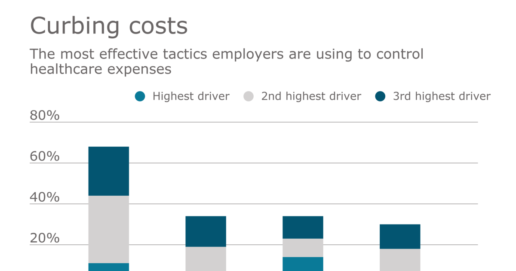ACA: 4 things employers should focus on this fall
Yes, employers still need to worry about the Affordable Care Act and its many rules and regulations. Read this blog post for more information.
During the coming months, employers may have questions about whether they still need to worry about the Affordable Care Act (ACA). The answer is yes; the ACA is alive and well, despite renewed legal challenges and the elimination of the individual mandate beginning next year.
While the Tax Cuts and Jobs Act reduced the tax penalty for individuals who don’t have health coverage to $0, effective for 2019, employers are still subject to penalties for failing to comply with certain ACA rules. For example, the IRS is currently enforcing “employer shared responsibility payments” (ESRP) penalties against large employers who fail to meet the ACA requirements to offer qualifying health coverage to their full-time employees. For this purpose, large employers are those with 50 or more full-time or full-time equivalent employees. Here are four things about the ACA that employers should focus on now to avoid significant financial liabilities.
1. The IRS is currently assessing penalties using 226-J letters
In 2017, the IRS began assessing ESRP penalties against large employers that failed to offer qualifying health coverage to at least 95 percent of their full-time employees. An ESRP penalty assessment comes in the form of a 226-J letter, which explains that the employer may be liable for the penalty, based on information obtained by the IRS from Forms 1095-C filed by the employer for that coverage year, and tax returns filed by the employer’s employees. The employer has only 30 days to respond to the 226-J letter, using IRS Form 14764, which is enclosed with the 226-J letter. The employer must complete and return IRS Form 14765 to challenge any part of the assessment.
The short timeframe for responding to a 226-J letter means that staff who are likely to be the first to receive communications from the IRS should have a plan in place to react quickly. Training for staff should include information about who to notify and what documentation to keep readily available to support an appeal. Not responding to the IRS 226-J letter will result in a final assessment of the proposed penalty. These penalties can be significant. In the worst case, an employer with inadequate health coverage could pay for the cost of the coverage, as well as penalties of $2,000/year (as indexed) for every full time employee (less 30), even those who received health coverage from the employer.
Depending on the employer’s response to the initial assessment, the IRS will then send the employer one of four types of 227 acknowledgment letters. If the employer disputes the penalty, the IRS could accept the employer’s explanation and reduce the penalty to $0 (a 227-K letter). But if the IRS rejects any part of the employer’s response, the employer will receive either a 227-L letter, with a lower penalty amount, or a 227-M letter, a notice that the amount of the initial assessment hasn’t changed. These letters will explain steps the employer has to take to continue disputing the assessment, including applicable deadlines. The next phase of the appeal might include requesting a telephone conference or meeting with an IRS supervisor, or requesting a hearing with the IRS Office of Appeals.
2. ACA reporting requirements and penalties still apply
Along with the ESRP penalties, the Form 1094-C and 1095-C reporting requirements still apply to large employers. The IRS uses information on Forms 1095-C in applying the ESRP rules and deciding whether to assess penalties against the reporting employer. Large employers must file Forms 1095-C every year with the IRS and send them to full-time employees in order to document compliance with the ACA requirement to offer qualified, affordable coverage to at least 95 percent of full-time employees. Technically, the forms are due to employees by January 31, and to the IRS by March 31, each year, to report compliance for the prior year. In the past, the IRS has extended the deadline for providing the forms to employees, but not the deadline for filing with the IRS.
Penalties can apply if an employer fails to file with the IRS or provide the forms to employees, and the penalty amount can be doubled if the IRS determines that the employer intentionally disregarded the filing requirement. These penalties can apply if an employer fails to file or provide the forms at all, files and provides the forms late, or if the forms are timely filed and provided, but are incorrect or incomplete.
In some instances, the IRS has assessed ESRP penalties based on Form 1095-C reporting errors. So, in addition to the reporting-related penalties, inaccurate information on Forms 1095-C can lead to erroneous ESRP assessments that the employer will then need to refute, using the IRS forms and procedures described above.
Employers should carefully monitor their ACA filings and reports, and consider correcting prior forms if errors are discovered. Employers should also continue tracking offers of coverage made for each month of 2018, to prepare for compliance with the Form 1095-C reporting requirement early in 2019.
3. “Summary of Benefits and Coverage” disclosure forms are still required
The ACA added a new disclosure requirement for group health plans, called a “Summary of Benefits and Coverage” or “SBC,” that’s intended to help employees make an “apples to apples” comparison of different benefit plan features, such as deductibles, out-of-pocket maximums, and copayments for various benefits and services. This requirement still applies, and SBCs must be provided during open enrollment, upon an employee’s initial eligibility for coverage under the plan, and in response to a request from an employee. The template SBC form and instructions for completing it were updated for coverage periods starting after April 1, 2017. For 2018, a penalty of $1,128 per participant can apply to the failure to provide an SBC as required.
4. The “Cadillac Tax” has not been repealed
The ACA’s so-called Cadillac tax — an annual excise tax on high-cost health coverage — was initially scheduled to take effect in 2018. The Cadillac tax has been repeatedly delayed, and the federal budget bill passed in January delayed it again through December 31, 2021. Despite the repeated delays, the Cadillac tax has not been repealed and is currently scheduled to apply to health coverage offered on or after January 1, 2022. This might be an issue to consider for employers who are negotiating collective bargaining agreements in 2018 that include terms for health benefits extending beyond 2021.
While uncertainty continues to surround the ACA, employers should remain aware of continuing compliance requirements to avoid the potentially significant penalties that remain in effect under the ACA.
Boyette, J; Masson, L (21 August 2018) "ACA: 4 things employers should focus on this fall" (Web Blog Post). Retrieved from https://www.benefitspro.com/2018/08/21/aca-4-things-employers-should-focus-on-this-fall/
15 employee benefits on the rise
A number of benefits, other than employer-sponsored health insurance and retirement plans are on the rise. Read this blog post to learn more.
Employer-sponsored health insurance and retirement plans are always a vital part of the employee benefits conversation. But a number of other benefits — think wellness and perks that promote work-life balance — are becoming table stakes as employers look to attract and retain talent in a tightened labor market. Here are 15 of the employee benefits that are on the rise, according to the Society for Human Resource Management’s recently released annual benefits survey.
Health savings accounts
Paid parental leave
The availability of paid parental leave increased significantly between 2016 and 2018 for every type of parental leave, according to SHRM. Paid maternity leave increased from 26% in 2016 to 35% in 2018, and paid paternity increased from 21% to 29%. Meanwhile, adoption (20% to 28%), foster child (13% to 21%) and surrogacy (6% to 12%) leave also increased in the last two years.
A number of large employers have added or enhanced paid parental leave programs in the last year. Dollar General, TD Bank and Unum are among the companies that added parental leave benefits for employees, while IBM, TIAA and Walmart are among those that expanded their programs.
Company-organized fitness competitions/challenges
Standing desks
Standing desks are one of the fastest-growing employee benefits: The percentage of employers offering standing desks to workers increased from 20% in 2014 to 53% in 2018. In the last year alone, the benefit increased 8 percentage points.
Research indicates long hours of sitting are linked to obesity, diabetes, heart disease and cancer, so employers are looking for benefits to help combat the problem.
Critical illness insurance
Telecommuting
CPR/first aid training
Acupressure/acupuncture medical coverage
Onsite stress management programs
Lactation rooms
Casual dress benefits
Service anniversary awards
Spot bonuses
Life insurance
Paid time off to volunteer
Amazon has just entered the drug-distribution business
Amazon is on top, knocking big competitors out one by one. Today, they take down pharmacies by offering online health-care services. See what Amazon has in store here.
Amazon.com Inc. agreed to buy the online pharmacy startup PillPack, jumping into the health-care business with a deal that will give the retail giant an immediate nationwide drug network.
The move represents a formidable threat to pharmacy chains including Walgreens Boots Alliance Inc., which earlier Thursday reported tepid U.S. same-store sales, and rival CVS Health Corp. Walgreens was down 10 percent at 10:18 a.m. in New York, while CVS shares shed 8.9 percent.
Terms of the deal weren’t disclosed. The transaction is expected to close in the second half of 2018, according to a statement from the companies.
The U.S. market for prescription medicine is huge. In 2016, U.S. consumers spent $328.6 billion on retail prescription drugs, according to the U.S. government. CVS reported prescription sales of $59.5 billion last year, and Walgreens sold $57.8 billion worth of drugs in its fiscal 2017.
PillPack has mail-order pharmacy licenses in all 50 U.S. states, which could allow Amazon to expand quickly. PillPack also has relationships with most major drug-benefit managers, including Express Scripts and CVS, and says it works with most Medicare Part D drug plans. Those ties will give Amazon access to much of the prescription drug market in the U.S.
PillPack sells pre-sorted packets of prescriptions drugs, delivering them to customers in their homes. The closely held firm has software that automates many routine pharmacy tasks, such as verifying when a refill is due, determining co-pays, and confirming insurance. That eliminates much of the manual work that pharmacists often are saddled with now.
The pact follows months of speculation about Amazon’s plans to get into the pharmacy or drug-distribution business. Despite the retailer’s vast reach, entering the market presented a daunting logistical challenge in terms of licensing and dealing with a range of private and government payers. Acquiring PillPack’s networks helps Amazon surmount those hurdles.
Michael Rea, chief executive officer of Rx Savings Solutions, said PillPack could transform the industry and that employers and health plans would benefit from the deal, which he called a “sign of the times.”
“This move signals just how big of a market opportunity there is to change the pharmacy landscape,” Rea said in an email.
Amazon has been disrupting businesses from electronics to household staples and even package delivery. Pharmacy and health-benefits companies have long fretted that they’d be next. Chief Executive Officer Jeff Bezos signaled his interest in health-care earlier this year when he teamed up with Berkshire Hathaway Inc.’s Warren Buffett and JPMorgan Chase & Co.’s Jamie Dimon to form a health-care company to manage the health plans of their more than 1 million employees.
The selloff in drugstore stocks was reminiscent of the food-industry swoon that resulted in June 2017 when Amazon said it was buying Whole Foods Market Inc. Kroger Co., the biggest U.S. supermarket chain, saw $2 billion in market value wiped out in one day. Big packaged food stocks also took a hit.
“When Amazon sneezes, everybody else catches a cold,” said Joseph Feldman, an analyst with Telsey Advisory. “And I think that that’s more likely than not what you’re going to see today.”’
Long time coming
Prescription drugs sales are largely intertwined with groceries and personal items like makeup and shampoo and Amazon already sells bulk packs of latex gloves, bed pads and syringes. It recently began selling medical devices and instruments, as well.
Bezos has been thinking about the drug business for nearly two decades; in 1999, Amazon purchased a stake in Drugstore.com. That effort ultimately failed and Walgreens purchased the money-losing startup in 2011 and ultimately shut it down.
Pharmacist TJ Parker and computer scientist Elliot Cohen founded PillPack in 2013 after meeting at a medical-technology program at the Massachusetts Institute of Technology. The company raised more than $118 million from brand-name investors including Accel, Sherpa Capital and New York rapper Nas’s Queensbridge Venture Partners.
A September 2016 funding round valued the Boston-based startup at around $360 million, according to venture-capital database PitchBook. In April, CNBC reported Walmart Inc. was in talks to buy the company for “under $1 billion,” citing unnamed sources.
Standing firm
For now, Walgreens indicated that it was in no hurry to find a deal to respond to Amazon, despite the damage to its stock. On an earnings conference call, Walgreens CEO Stefano Pessina faced multiple questions from analysts about the PillPack deal.
“It is a declaration of intent from Amazon,” said Pessina.
He said Walgreens knew that PillPack was for sale as “it had been for sale for a while,” but that the retailer wouldn’t do deals based on emotions or make moves that could destroy value. Pessina insisted that physical pharmacies would continue to be “very important.”
The slump in Walgreens shares weighed on the Dow Jones Industrial Average, which added the stock to its index of 30 companies this month, replacing General Electric Co.
SOURCE:
Langreth R and Tracer Z (29 June 2018) "Amazon has just entered the drug-distribution business" [Web Blog Post]. Retrieved from https://www.benefitspro.com/2018/06/28/amazon-has-just-entered-the-drug-distribution-busi/
Half of Americans think the ACA marketplace is collapsing
Most Americans are happy with the insurance they buy on the individual market, yet those same people think the markets are collapsing before their eyes.
A poll by the Kaiser Family Foundation (Kaiser Health News is an editorially independent program of the foundation), released Tuesday, found that 61 percent of people enrolled in marketplace plans are satisfied with their insurance choices and that a majority say they are not paying more this year compared with last year’s premium costs.
Yet, more than half of the overall public — 53 percent — also think the Affordable Care Act’s marketplaces are “collapsing.”
Experts have warned that some policy actions supported by the Trump administration would undermine the market, including repealing the penalty for going without insurance and giving people the option to buy short-term plans. Such plans are often less expensive but cover fewer benefits. They are not automatically renewable, and insurers are able to charge people with medical conditions more — or exclude them altogether.
But only about one-fifth of people who obtain coverage on the individual market were even aware that the mandate penalty had been repealed as of 2019, according to the poll. It is still in effect this year.
Nine in 10 enrollees said they would still buy insurance without the penalty, and 34 percent said the mandate was a “major reason” they chose to buy insurance at all.
“They may have been prompted to buy the coverage in the first place because of the mandate,” said Sabrina Corlette, a professor at Georgetown University’s Health Policy Institute. “But now that they’ve got it, they clearly value it.”
Most of the people who buy plans because they don’t get coverage through work or the government, 75 percent, said they bought insurance to protect against high medical bills, and 66 percent said peace of mind was a major reason.
In February, President Donald Trump eased some of the restrictions on short-term insurance plans, allowing them to cover people for 12 months instead of three.
Critics worried this alternative would draw people away from traditional insurance plans and weaken the individual market. According to the poll, though, only 12 percent of respondents buying on that market said they’d be interested in buying one of the short-term plans.
Georgetown’s Corlette cautioned that these numbers could change when people are faced with an actual choice next open enrollment season.
“If you look at how these things are marketed, your average consumer will not be able to tell that these products are any different from a traditional health plan,” she said.
Most people said they didn’t face a premium increase this year. Thirty-four percent said their premiums were “about the same” as last year and 23 percent said they actually went down.
That’s not surprising, said Joseph Antos, a resident scholar at the conservative American Enterprise Institute who follows the health industry. Many consumers saw their premium subsidies rise too.
Thirty-five percent of people said one of the major reasons they bought insurance was because government subsidies made it affordable.
The subsidies that people receive, Antos noted, went up to offset the premium increase in many cases, especially if consumers took the advice of experts and shopped around for coverage.
“They’re buying because they feel they need insurance and that their net premiums and deductibles add up to something they’re willing to buy,” Antos said.
The poll was conducted Feb. 15-20 and March 8-13 among 2,534 adults. The margin of sampling error is +/-2 percentage points for the full sample, +/-7 percentage points for all non-group enrollees and +/-9 percentage points for marketplace enrollees.
Source: Kaiser Health News senior correspondent Julie Appleby contributed to this report.
By Rachel Bluth, Kaiser Health News | April 03, 2018 at 10:06 AM | Originally published on BenefitsPro
Healthcare analytics market grows as providers take aim at cost-cutting
A combination of artificial and human intelligence data analytics, offering the opportunity to bring greater customization to medical approaches, is expected to increase in demand over the next few years.
 Data-enriched tools have cut the communication gap between caregivers and patients even as they provide a large amount of data that can be used to create personalized treatments. (Image: Shutterstock)
Data-enriched tools have cut the communication gap between caregivers and patients even as they provide a large amount of data that can be used to create personalized treatments. (Image: Shutterstock)
The need by hospitals and other health care providers to cut the cost of providing care is helping to drive up the global health care/analytics market, to reach an anticipated worth of $53.65 billion by 2025.
That’s according to a new report by Grand View Research, Inc., which says that hospitals are already using health care analytics to manage the number of workers working in a particular shift.
Citing the example of a hospital in Paris that uses health care analytics to predict the number of patients that may be hospitalized, the report points out that such data can be used to decide the number of staff members that will be needed for a particular shift, thus assisting in driving down the cost of labor in hospitals.
Data-enriched tools such as mHealth, eHealth, Electronic Health Records and mobile applications have cut the communication gap between caregivers and patients even as they provide a large amount of data that can be used to create personalized treatments. However, patients might hesitate to use such tools; that could weigh on the implementation of analytics.
But a combination of artificial and human intelligence data analytics, offering the opportunity to bring greater customization to medical approaches, is expected to expand demand for such tools over the next few years.
Among other findings in the report is the significant market share held by descriptive analytics in 2015 because of its applications in process optimization in organizations. In addition, the services category dominated the component segment in 2015, with outsourcing of big data services contributing to their growth in aiding the high volume of services rendered.
The hardware systems category came out the winner in the component segment, with the high cost of hardware contributing to its growth, while on-premise delivered analytic services dominated the delivery mode category in 2015, capturing a market share of approximately 54.0 percent.
North America has captured a significant share in the global market, the report finds, with advanced health care infrastructure in the region and growing per capita health care spending supporting greater consumption of these services.
Source:
By Marlene Satter | April 02, 2018 at 12:13 PM | Originally published on BenefitsPro
Direct Primary Care Begins to Change the Mindset Behind Healthcare
A new kind of doctor's office that doesn't take insurance and charges a monthly fee is 'popping up everywhere' — and that could change how we think about healthcare
Bryan Hill spent his career working as a pediatrician, teaching at a university, and working at a hospital. But in March 2016 he decided he no longer wanted a boss. Soon after, Hill learned about a different way to run a doctor's office. "It's the most fun I've ever had," Hill said. Now almost 18 months into his practice, he said, "I couldn't imagine practicing any way else." Hill's practice is something known as direct primary care. Instead of accepting insurance for routine visits and drugs, these practices charge a monthly membership fee that covers most of what the average patient needs, including visits and drugs at much lower prices. Hill is part of a small but fast-growing movement of pediatricians, family-medicine physicians, and internists opting for this different model. It's happening at a time when high-deductible health plans are on the rise.
A survey in September 2016 found 51% of workers had a plan that required them to pay up to $1,000 out of pocket for healthcare until insurance picks up most of the rest. That means consumers have a clearer picture of how much they're spending on healthcare just as they're having to pay more. At the same time, primary-care doctors in the traditional system are feeling the pressure under the typical fee-for-service model in which doctors are pressured to see more patients. The direct primary-care movement — in which practices are set up on a doctor-by-doctor basis — has been slowly but steadily growing over the past few years, adding about 170 practices in the past year despite some larger practices shutting down.
Direct primary care has the potential to simplify basic doctor visits, giving doctors time to focus just on the patient and care for them in ways they might not have had time for otherwise. But there are also concerns from insurers about what separating insurance from primary care will mean for people who still ultimately need insurance. Members of direct primary-care practices pay a monthly fee, which, depending on the practice, your age, and the number of family members you have on the plan, can run from $50 to $150. Included in that monthly fee are basic checkups, same-day or next-day appointments, and — a boon to patients — the ability to obtain medications and lab tests at or near wholesale prices.
Direct primary care also comes with near-constant access to a doctor — talking via FaceTime while the family is on vacation, or taking an emergency trip to the office to get stitches after a bad fall on a Saturday night. Because direct primary care doesn't take insurance, there are no copays and no costs beyond the monthly fee. Doctors can also take the time to keep in touch with patients in between visits to see how they're doing. Paul Thomas, whose practice in Detroit has grown from 50 members to 250 in the past year, will text his patients once a week working on long-term goals like losing weight, eating better, or quitting smoking. He'll check in with the patient, initiating a conversation and keeping the goal in their mind in a way that an infrequent visit to the doctor's office might not. The number of people in a particular practice who have insurance varies, according to the 17 direct primary-care practices Business Insider spoke to. At some practices, all but a handful had some form of insurance, while at others a little more than half didn't have insurance. To describe how coverage functions under direct primary care, doctors use the example of car insurance.
You don't use your car insurance for small transactions like oil changes, but it's there for you if you get in a car accident. Likewise, health-insurance plans — especially those with high deductibles — can be there if you require healthcare beyond just a standard checkup. While the number of direct primary-care practices is growing, it's not exploding in the same way a national chain might be able to. For the most part, doctors build their own practice, which keeps it local.
—businessinsider.com
Could These 3 Reasons Be Behind Your Failing Employee Engagement?
Encouraging employee engagement with health benefits
In a competitive economy, a robust package of employee health benefits is one of the key elements that employers need to attract and to retain a skilled, experienced workforce. In fact, according to statistics gathered by Collective Health and Harris Poll, 78% of adults in the U.S. say healthcare benefits strongly factor into their decision on where to accept a job. However, once employees have these benefits, most do not take full advantage of the complete range of services and support available. Only 25% of employees questioned in one survey said they have used all the preventive care benefits offered by their employer.
Another survey, conducted by the American Psychological Association, found that only 33% of employees report participating in employer-provided health promotion programs. The failure to engage with and use the benefits available can have an especially significant impact when employees or their family members face serious or complex medical issues, such as a cancer diagnosis or recommendation for surgery. When employees don’t use the full spectrum of benefits available to them, such as second opinions and case management, the risk of poorer health outcomes and higher employer and employee healthcare costs increases, with more than $210 billion a year spent on inappropriate and unnecessary treatment according to an Institute of Medicine report. Several factors contribute to employees’ failure to use all the health benefits available to them:
Problems with the benefits selection process: Although the choice of benefits can have wide ranging effects on both physical and financial health, 77% of employees spend 60 minutes or less choosing benefits, while 46% spend 30 minutes or less on this important decision, according to an Aflac poll. Another survey noted the high stress levels associated with making benefit decisions, finding that 49% of employees say making benefits decisions is always stressful.
Not understanding the options: A survey by the International Foundation of Employee Benefits Plans found that approximately 80% of organizations reported that employees do not have a high level of understanding of their benefits. This lack of understanding comes at a financial cost. According to 42% of employees in the Aflac survey, the estimated cost of errors employees make understanding and choosing benefits can cost them up to $750 per year.
Complexity of benefits: When faced with multiple benefit providers and contact points, employees often do not know where to find the information they need to understand the benefits available to them and how to access them. As a result, employees fail to access the information, resources and support that can help them make informed medical decisions. This can have a negative impact on health outcomes and healthcare costs.
—benefitnews.com









